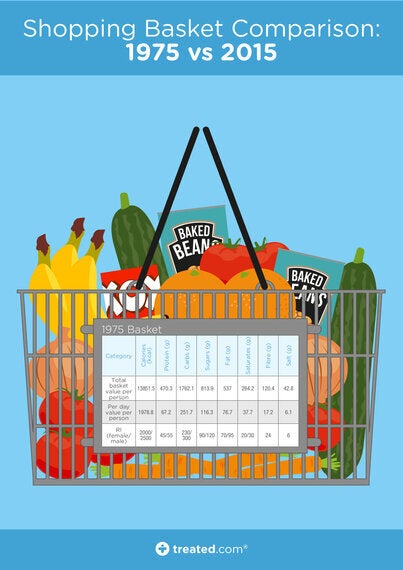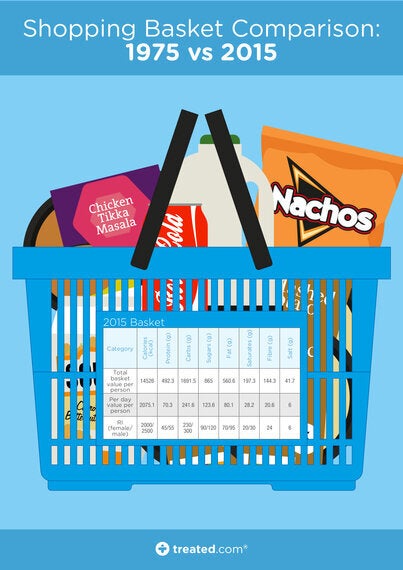Our knowledge of food and range of choice has improved significantly in the last 40 years. While dishes from the continent were only just starting to make their way onto household dinner tables in the 1970s, today they're a staple of many a family meal.
In addition to this, our standard of living has improved and the price of food relative to income has fallen. A better capacity to store food at home (more than 90 percent of UK households in 2015 has access to a freezer, compared with less than 10 per cent in 1970) has also made it easier for us to prepare dishes from scratch.
However, obesity has increased sharply. In the early 1970s, less than 5% of the UK population was obese. Today, around a quarter of the nation has a BMI of 30 or above.
There are several factors at the source of this steep rise; but I wanted to take a more detailed look at how much of an impact what we're buying from the supermarket could be having.
So I decided to assemble two average grocery shops from different eras - one from 2015, and one from 1975 - and see how they measure up in terms of nutritional value.
Here's what I found (click on the images to enlarge):


How were the groceries chosen?
- The lists were drawn up based on three square meals per day: breakfast, light lunch, and an evening meal.
- Some popular snack options from the 1970s were added, along with their modern day equivalent.
- Ready meals are a staple of many a 2015 basket, but in the 1970s, the choice of these was obviously much narrower.
- To reflect this, the earlier basket was compiled with more fresh produce: ingredients to make the evening meals which were considered 'rising stars' of the time.
- One junk food night has been allotted and I've included a traditional rustic family choice for the weekend in the form of sausage and mash.
- In the latter basket are the chilled ready meal versions of these rising stars, along with some other popular favourites. Sausage and mash has been kept for one weekend evening meal but on Saturday I've included a heat-up-at-home chilled Indian meal.
- Where possible, the latter basket includes healthier and lower fat versions of the staple items from the 1970s basket, (olive spread instead of butter, semi-skimmed instead of whole milk) as these are exponentially more popular (and available) than they were 40 years ago.
What are the main differences?
- The lunch and breakfast staples (corned beef and whole milk) in the 1970s basket are much higher in calories and saturated fat, but the shortfall in the 2015 basket is made up in other areas.
- The pre-packaged evening meal choices from the chilled section of the supermarket are, overall, higher in saturated fat than their prepared-from-scratch 1970s counterparts.
- This suggests that we could be eating more fat and saturated fat in our evening meal; and fat eaten later on in the day is biologically harder for the body to shift.
- Deserts and ice creams have become more elaborate and, as you might expect, denser in terms of fat and sugar content. A prime example might be the popularity of plainer ice creams in the 1970s, such as vanilla or neapolitan ice cream, compared to much more indulgent and complex varieties available today, such as the Ben and Jerry's line.
- So while the latter basket contains healthier and lower fat staple options, it also contains more 'empty calorie foods' in the form of sugar and snacks.
- The choice of wholemeal bread bumps up the fibre count for the modern basket considerably. Wholewheat and granary breads are now much more wide-ranging and readily available; and this somewhat makes up for the fibre value which has been lost through less 'cooking meals from scratch'.
'It's very interesting to see that the calorie, fat and saturated fat content of the two baskets is fairly stable.' Charlotte Stirling-Reed, registered nutrition consultant and owner of SR Nutrition said of the data.
'There has been a huge effort to reduce salt in our foods in the last 40 years, resulting in marked changes to the amount of salt there is in foods like bread and breakfast cereals; and so I was surprised to see the salt content of our 2015 basket still so high.'
The inclusion of more chilled ready meals in the 2015 basket is a major factor in this; pre-prepared foods may save time, but the fact remains that we have less control over what we consume and our portion sizes when we don't prepare it ourselves.
'I'm not surprised, however, that the sugar content of the 2015 basket is higher than in 1975.' Charlotte added.
The increased presence of sweet snacks and desserts, indicated by the explosion in availability of more elaborate and indulgent choices on supermarket shelves, is perhaps the leading catalyst in this; and these empty calories compensate for those we drop elsewhere.
Change in habits
On the surface, an overall comparison of the two baskets presents little difference in terms of fat, calorie and salt content; any discrepancies between individual items from 1975 and their modern-day equivalents are evened out when considered in their totality.
However, it is the difference in where these calories and fat come from in the latter basket, and the way we're eating them, that may indicate why we're seeing an increase in obesity and diet-related disease.
Let's also not forget that people today are much more likely to deviate from their original meal plan at short notice and order out, thanks again to increased choice and availability when it comes to takeaway food.
As Charlotte explains:
'Some of the factors that are likely to be contributing to the obesity epidemic include the fact that we live in what is known as an 'obesogenic' environment.'
'We now live in a world where access and availability of food is huge and changes and advances in food production mean that a lot of the foods we have such liberal access to are often energy dense and nutrient poor.'
With this in mind, whereas what we put into our shopping baskets may have painted the full picture in 1975, it only paints half the picture in 2015.
You can find the full results of the study on my blog over at Treated.com.